South Korea #2 – DMZ – UN Memorial Cemetery – December 2014
Tearing ourselves away from our comfortable campsite in the beach town of Samcheok, we headed north to the DMZ, (Demilitarized Zone – East Coast). Just to give you a little history, at 4 o’clock in the morning on June 25, 1950 North Korea carried out a sudden attack against South Korea led by Russian tanks. That was the beginning of the Korean War. Countries from around the world came to South Korea’s rescue. Under the banner of United Nations Forces, 40,896 soldiers from 17 Countries gave their lives to protect the Republic of Korea against the communist aggression. (Under the UN banner there were actually 16 nations – plus South Korea – actively fighting, 7 countries supplied medical support and 5 countries other support.)
The DMZ (Demilitarized Zone)
divides the Korean Peninsula
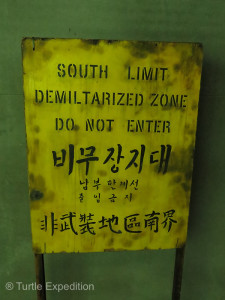 The DMZ cuts the Korean Peninsula roughly in half, crossing the 38th parallel on an angle, with the west end of the DMZ lying south of the parallel and the east end lying north of it. It was created as part of the Korean Armistice Agreement between North Korea, China, and the United Nations Command Forces in 1953. But the “war” is not over. 28,500 United States Forces Korea (USFK) troops still assist the South Korean military in guarding the DMZ. ——We did not see any US forces but the South Korean Army certainly made its presence all along the east coast (where we traveled)——South Koreans see the U.S. military presence as a sign of Washington’s steadfast support in the event of a North Korean offensive and we hope this still holds true in 2019. Sporadic outbreaks of violence due to North Korean hostilities killed over 500 South Korean soldiers and 50 U.S. soldiers along the DMZ between 1953 and 1999.
The DMZ cuts the Korean Peninsula roughly in half, crossing the 38th parallel on an angle, with the west end of the DMZ lying south of the parallel and the east end lying north of it. It was created as part of the Korean Armistice Agreement between North Korea, China, and the United Nations Command Forces in 1953. But the “war” is not over. 28,500 United States Forces Korea (USFK) troops still assist the South Korean military in guarding the DMZ. ——We did not see any US forces but the South Korean Army certainly made its presence all along the east coast (where we traveled)——South Koreans see the U.S. military presence as a sign of Washington’s steadfast support in the event of a North Korean offensive and we hope this still holds true in 2019. Sporadic outbreaks of violence due to North Korean hostilities killed over 500 South Korean soldiers and 50 U.S. soldiers along the DMZ between 1953 and 1999.
North Korea is still a serious threat
Coils of razor wire along the beaches and costal highways were clear evidence that the threat from North Korea is still very present as we found out in Samcheok. We were told that North Koreans sneak up the beaches at night and on occasions, there had been shoot-outs between military and invaders. The excellent DMZ Museum near the entry to the controlled zone was a real education.
We filled out all the necessary forms and received our pass to drive as far as the Unification Observatory north of the village of Myeongpa. We were not able to actually see any of the military posts, but the viewing deck left much to our imagination. The natural isolation along the 250 km (160 mi) length of the DMZ has created an involuntary park, which is now recognized as one of the most well preserved areas of temperate habitat in the world —- except for the land mines.
The United Nations Memorial Cemetery
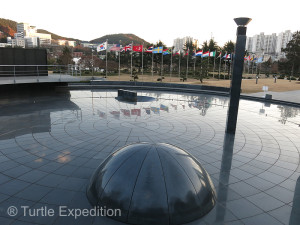
The center of the only UN Cemetery in the World was a beautiful reflection pool surrounded by flags representing all the countries who fought for South Korea’s freedom.
A couple of weeks later, we visited the UN Memorial Cemetery of Korea, (UNMCK), in the city of Busan. Beautifully landscaped, in 1973, the cemetery was transferred from the UN to the Commission for the United Nations Memorial Cemetery (CUNMCK. To this day maintained by UN service personnel, it is the only UN cemetery of its kind in the world. The Wall of Remembrance was especially impressive, with the names of the 36,492 Americans and 4,404 other nationalities who died in the fight for South Koreans’ freedom, many of whom were buried on sight. An eternal flame burns over a reflection pool.
Honor, Freedom, Peace
It was a tragic war and a terrible loss of men and women, but looking at South Korea today, the monument in the American section says it all. “HONOR, FREEDOM, PEACE”. It’s a goal that seems to have been reached in this modern nation.
- Coils of razor wire on the beaches and serious fences along coastal highways left no doubt that there was still a real threat from invading North Koreans.
- While we camped in the small harbor near the DMZ we spotted this unit of Korean soldiers. They also patrol the beaches at night.
- The final few miles on the highway towards the DMZ were obviously prepared to stop any threat from North Korea.
- Security was tight on the South Korean side. We were thoroughly checked and verified before receiving our passes to enter.
- Gary is holding our special permit car pass.
- While standing on top of the Unification Observatory Monika spots a village at the base of the distant mountains. We were told that the peninsula in the middle of the bay belongs to South Korea.
- The natural isolation along the 250 km (160 mi) length of the DMZ has created an involuntary park, which is now recognized as one of the most well preserved areas of temperate habitat in the world—-except for the land mines.
- The DMZ museum is very impressive and thought provoking.
- The DMZ cuts the Korean Peninsula roughly in half, crossing the 38th parallel on an angle.
- 4 o’clock in the morning on June 25, 1950 North Korea carried out a sudden attack against South Korea.
- This P51 Mustang was on display at the DMZ’s Unification Observatory.
- This photo in the DMZ Museum showed UN forces entering Seoul, Korea at the beginning of the war.
- On July 27, 1953 an armistice was signed formally ending the war in Korea. It was the end of the longest negotiated armistice in history: 158 meetings spread over two years and 17 days.
- Soldiers from North and South Korea stand yards apart at the DMZ. There is a lot of posturing being done. Gary had to join the South Korean soldier in the stare-down.
- The Tree Of Hope at the Goseong Demilitarized Zone Museum gave people a way to share their wish for peace.
- Gary dedicated his leaf to his cousin Don Fitchett who fought in the Korean War.
- Monika added her wish for Peace to all Koreans.
- What a beautiful symbol for a wish for Peace!
- Each butterfly was in itself a piece of unique art.
- DMZ – Demilitarized Zone was cleverly changed into a Dream Making Zone poster.
- We found the Korean people uniformly polite, friendly and pro American and Swiss. They were amazed that we had come all the way from California in our own vehicle. At this point, we were too!
- The beautifully landscaped UN Memorial Cemetery of Korea, located in Busan, is the only UN cemetery of its kind in the world.
- Trees were artfully clipped.
- Many of the 40,896 soldiers from 17 countries who gave their lives to protect the Republic of Korea against the communist aggression are buried here.
- The monument in the American section says all. “HONOR, FREEDOM, PEACE”.
- This wall lists all the US service members lost in the Korean War.
- From where Monika was standing to the end of the inner wall were all names of dead soldiers from California. It was shocking!
- The center of the only UN Cemetery in the World was a beautiful reflection pool surrounded by flags representing all the countries who fought for South Korea’s freedom.
- An eternal flame burns over a reflection pool in front of The Wall of Remembrance with the names of the 36,492 Americans and 4,404 other nationalities that died in the fight for South Korean’s freedom.



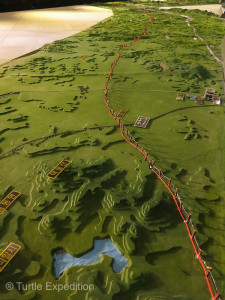
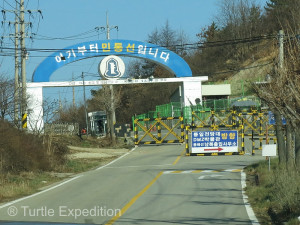
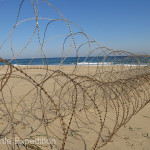
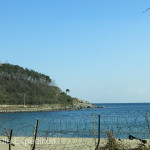
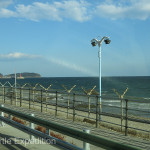
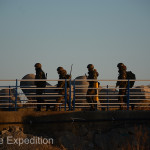
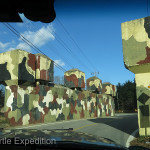
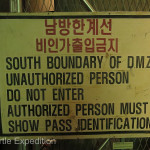
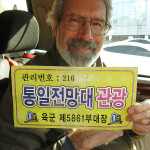
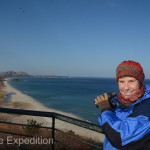
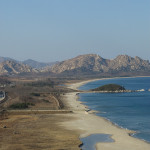
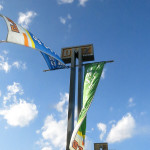
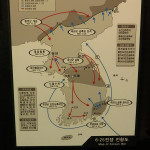
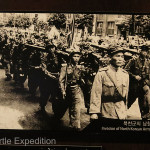
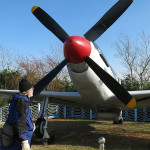
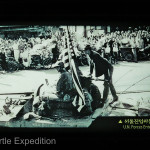
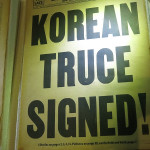
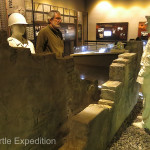
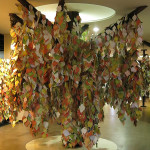
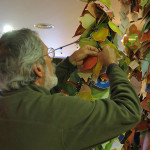
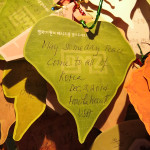
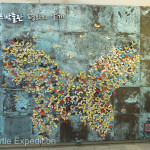

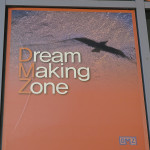
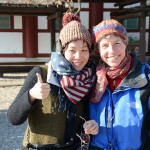
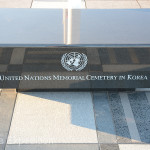
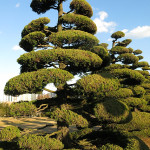
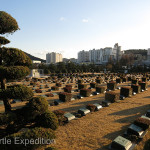
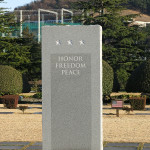
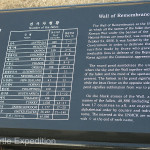
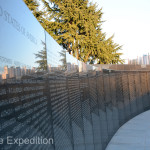
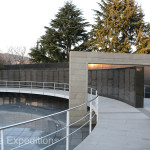
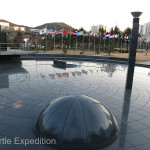
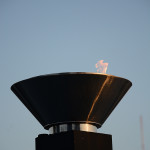





Leave a Comment